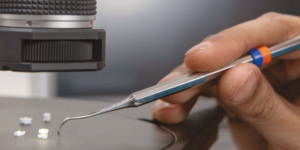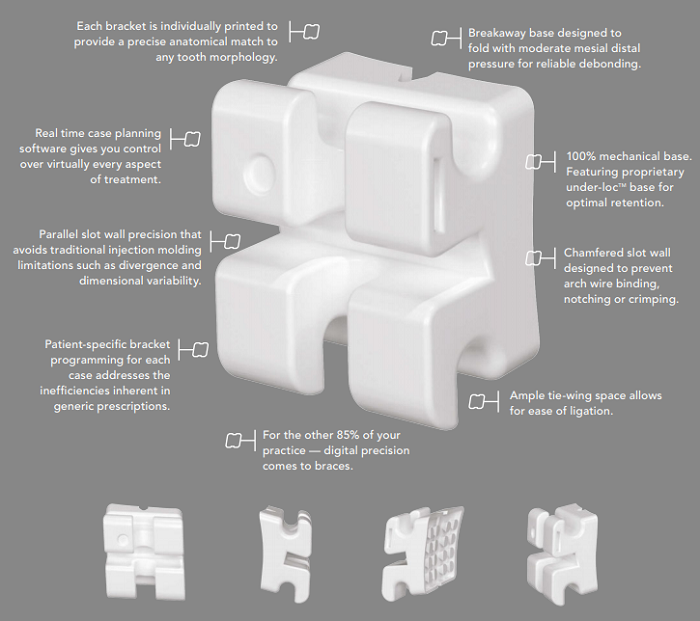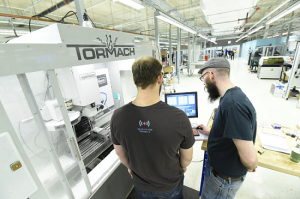DyeMansion raises $14 million to “drive the transformation” of additive manufacturing
Formnext launches 2020 3D printing Start-up Challenge
Incus lithography-based metal 3D printing technology to debut at Formnext 2019
Introducing LightForce Orthodontics and Its Customized 3D Printed Bracket System
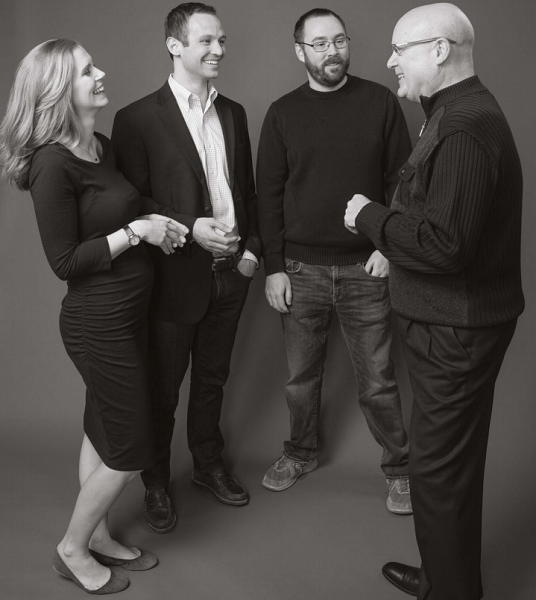
The LightForce Orthodontics team. L-R: Kelsey Peterson-Fafara, Dr. Alfred Griffin, Craig Sidorchuk, and Dr. Lou Shuman.
A dental resident walked into a bar full of Harvard graduate students. No, it’s not the beginning of a bad joke, but actually the genesis of venture-backed startup LightForce Orthodontics, which officially launched at this year’s American Association of Orthodontists (AAO) Annual Session. The team is making what it calls the world’s first customized 3D printed bracket system for the digital orthodontics field.
The startup’s founder and CEO, Dr. Alfred Griffin, comes from a long line of dentists, and had just completed a combined dental and PhD program at the Medical University of South Carolina before moving to Boston in 2015 to attend the Harvard School of Dental Medicine for his residency. He wasn’t used to the whiteout conditions of a hard New England winter, and spent a lot of time holed up in his apartment, dreaming up the innovative bracket system.
Dr. Larry Andrews and A-Company first introduced fully programmed brackets in 1970, and not a lot has changed since then.
“Standard orthodontic prescriptions are essentially a compromise from the outset,” explained Dr. Griffin in the special edition AAO issue of this year’s Orthodontic Practice US. “They are an “all patients equal” proposition. But no two patients have exactly the same tooth morphology or exactly the same bite. So why would we think they should all have the same ‘ideal’ finish?
“The concessions with pre-programmed brackets have been imposed by several constraining factors. Two of the primary constraints are inflexible bracket manufacturing technologies and the imprecision of analog treatment planning.”
It costs hundreds of thousands of dollars and takes anywhere from six to twelve months, using injection molding, to create molds for one standard prescription, which is about 20 brackets of different programming and shapes – not a realistic environment for patient-specific customization. So Dr. Griffin turned to 3D printing, which already has many applications in the dental and orthodontics fields, such as creating aligners, molds, implants, dentures, and even braces.
Most braces are “off the rack,” and even though skilled orthodontists can make this work, Dr. Griffin knew that 3D printing, which is a good fit for custom applications, could be used to make patient-specific braces. So he created a patented system for 3D printed orthodontic treatment brackets, using material nearly identical to injection modeled ceramic brackets but that’s been formulated specifically for 3D printing.
“Delivering a patient-specific prescription for each case, the LightForce system is unlike anything you’ve ever used,” claims the website. “Each bracket is custom created and 3D-printed, bringing a new level of flexibility and clinical possibilities. This enhances treatment efficiency and minimizes time-consuming adjustments in all phases of treatment.”
That same snowy winter, Dr. Griffin attended a local happy hour with Harvard graduate students, and after buying a few rounds, explained his idea to the group. Engineer Kelsey Peterson-Fafara immediately recognized the potential, and would soon be employee #1. Not long after LightForce, originally titled Signature Orthodontics, was accepted into the Harvard Innovation Lab accelerator, Dr. Griffin met orthodontist Dr. Lou Shuman, who had been an important member of the executive team for another dental company using 3D printing: Invisalign. He soon asked Dr. Shuman to be the company’s co-founder, and help reach out to the venture capital community.
![]() LightForce Orthodontics was one of 128 applicants chosen to join the MassChallenge Accelerator program in 2016, and became entrepreneurs-in-residence at the MassChallenge facility, later receiving $50,000 in equity-free financing as one of the 15 winners. The next step was locking down venture capital, but Dr. Griffin didn’t want to work with just anyone – he was looking to change how orthodontics works at a fundamental level, not just for a cash grab. The company’s first major funding came from AM Ventures (AMV), which is dedicated to investing in 3D printing.
LightForce Orthodontics was one of 128 applicants chosen to join the MassChallenge Accelerator program in 2016, and became entrepreneurs-in-residence at the MassChallenge facility, later receiving $50,000 in equity-free financing as one of the 15 winners. The next step was locking down venture capital, but Dr. Griffin didn’t want to work with just anyone – he was looking to change how orthodontics works at a fundamental level, not just for a cash grab. The company’s first major funding came from AM Ventures (AMV), which is dedicated to investing in 3D printing.
“We wanted a strategic investor — not just someone with money,” Dr. Shuman said. “We wanted expertise in our fundamental technology. AMV was an ideal partner for LightForce.”
Speaking of expertise, AMV introduced Dr. Griffin and Dr. Shuman to EOS founder and industry pioneer Hans Langer, who believes that LightForce has achieved the two most important components in the future of 3D printing: creating high value customization, and having a market that’s large enough to support it.
LightForce continued to grow, staying on as Alumni in Residence at MassChallenge through 2017, hiring expert dental software developers, finalizing the bracket design, and receiving FDA clearance for the system. The startup closed its Series A funding round last summer, enjoyed a successful debut at the 2019 AAO Annual Session, and has multiple patients in treatment who wanted to be the first to sport customized, 3D printed braces.
The brackets can be perfectly contoured to any tooth morphology. The initial system was made to compete with metal brackets, and LightForce is now working on higher-aesthetic options and looking at different materials, as well as perfecting its service and supply chain logistics. It’s a simple three-step digital workflow: scan, create the 3D model, and print. The online interface is intuitive, with cloud-based treatment planning software that allows users to make adjustments directly on the model, before the custom 3D printed appliance is shipped in just 7-10 business days after approval.
In order to keep up with a changing industry, LightForce’s treatment planning system will keep evolving as necessary. Aligners are becoming more capable, but many orthodontists still use braces for their patients, which is why LightForce is looking at the larger marketplace.
Dr. Griffin explained, “We don’t want to bring the idea to market and say `here’s how to use it.` We want to bring this to the orthodontist and ask them, ‘What can you do with it?’”
As direct-to-consumer companies gain popularity, Dr. Griffin wants the startup to acknowledge the expertise of the orthodontic community, and help the field, not just take it over.
Discuss this and other 3D printing topics at 3DPrintBoard.com or share your thoughts below.
The post Introducing LightForce Orthodontics and Its Customized 3D Printed Bracket System appeared first on 3DPrint.com | The Voice of 3D Printing / Additive Manufacturing.
3D Printing News Briefs: May 19, 2019
We’ve got business news and materials news for your weekend, just ahead of next week’s massive RAPID + TCT show. 3D Hubs and AM Ventures are both opening new offices, but in vastly different countries. BASF 3D Printing Solutions is launching a new TPU material for use with HP’s latest 3D printer series, and Freeman Technology will be hosting a seminar about AM powders next month.
3D Hubs Opening US Headquarters in Chicago
Two months ago, automated manufacturing platform 3D Hubs announced that it had received $18 million in Series C funding, some of which was earmarked for opening a dedicated US office to best serve the over 10,000 clients it serves here. Now, the company has announced that its new North American headquarters will be located in Chicago, Illinois, with the added bonus of an endorsement from the city’s Mayor Rahm Emanuel. This decision allows 3D Hubs to centralize its US workforce, and it plans to double the team at headquarters by the end of 2019. The offices will be located at the mHUB technology innovation center in the city’s West Town neighborhood, and are scheduled to open next month.
“3D Hubs joins the long list of international companies choosing Chicago for their future. With our growing tech economy and strong digital manufacturing community, Chicago is the perfect home for this innovative company,” said Mayor Emanuel. “I look forward to seeing 3D Hubs success in Chicago in the years to come.”
AM Ventures Opens Office in Korea
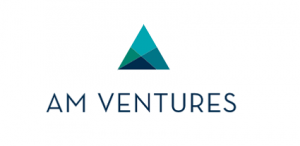 Germany-based AM Ventures Holding GmbH (AMV) is a top independent strategic investor in the AM industry, and over the last four years has been busily setting up an ecosystem of sustainable strategic investments, in addition to a partner network for using advanced manufacturing technologies in serial production. Now in an effort to further grow its technology venturing activities, it is expanding to the Asia Pacific region with a new office in Busan, Korea.
Germany-based AM Ventures Holding GmbH (AMV) is a top independent strategic investor in the AM industry, and over the last four years has been busily setting up an ecosystem of sustainable strategic investments, in addition to a partner network for using advanced manufacturing technologies in serial production. Now in an effort to further grow its technology venturing activities, it is expanding to the Asia Pacific region with a new office in Busan, Korea.
AMV’s Chief Venturing Officer Arno Held said, “AMV is pleased to announce the opening of its new office in Korea serving the Asia-Pacific region, a market which is already demonstrating active AM adoption for serial production and a large growth potential. AMV commits to this dynamic region and the investment opportunities available there.”
Having already moved to its new Korean home , AMV’s liaison office AM Ventures Asia has appointed Simon (Sangmin) Lee, a previous sales manager at the Korea office of EOS GmbH, as the Regional Director of Asia.
BASF 3D Printing Solutions Launches Ultrasint TPU Powder
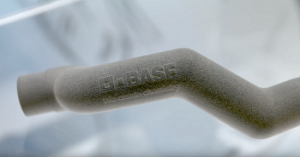 Rüdiger Theobald, the Senior Manager for Sales & Marketing in Powder Bed Fusion at BASF 3D Printing Solutions GmbH, discusses the company’s new Ultrasint TPU powder in a recent YouTube video. The highly flexible yet accurate material, which is perfect for automotive applications and coating and simulation solutions, was launched specifically for HP’s new Jet Fusion 5200 series.
Rüdiger Theobald, the Senior Manager for Sales & Marketing in Powder Bed Fusion at BASF 3D Printing Solutions GmbH, discusses the company’s new Ultrasint TPU powder in a recent YouTube video. The highly flexible yet accurate material, which is perfect for automotive applications and coating and simulation solutions, was launched specifically for HP’s new Jet Fusion 5200 series.
“Two great brands, two great companies merge together, both with innovative technologies on hand and a great new ecosystem to support the industry with a very innovative material,” Theobald said in the video.
“We have found out a good way to operate with different wall thicknesses, that makes it very reasonably usable for any kind of pressurized applications in regards of liquids or gas.”
Freeman Technology to Host Seminar on AM Powders
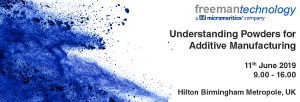 Next month, powder flow specialist Freeman Technology will be hosting a free seminar in the UK entitled “Understanding Powders for Additive Manufacturing.” The one-day event, which will take place on June 11th at the Hilton Birmingham Metropole, will introduce attendees to the principles of powder rheology, and explain how associated methodologies can also be applied in order to gain a better understanding of how to optimize powder for AM applications.
Next month, powder flow specialist Freeman Technology will be hosting a free seminar in the UK entitled “Understanding Powders for Additive Manufacturing.” The one-day event, which will take place on June 11th at the Hilton Birmingham Metropole, will introduce attendees to the principles of powder rheology, and explain how associated methodologies can also be applied in order to gain a better understanding of how to optimize powder for AM applications.
During the seminar, there will be a presentation from Freeman Technology’s Operations Director Jamie Clayton about understanding and measuring powder flow and behavior. Industry experts, such as Ricoh Material Specialist Enrico Gallino and Product Manager Cathryn Langley with Malvern Panalytical, will present about some of the major challenges when it comes to powder handling, including how to quantify the size and shape of metal powders for AM. Delegates will also have the chance to see a demonstration of the company’s FT4 Powder Rheometer. You can register for the seminar here.
Discuss these stories and other 3D printing topics at 3DPrintBoard.com or share your thoughts in the Facebook comments below.


